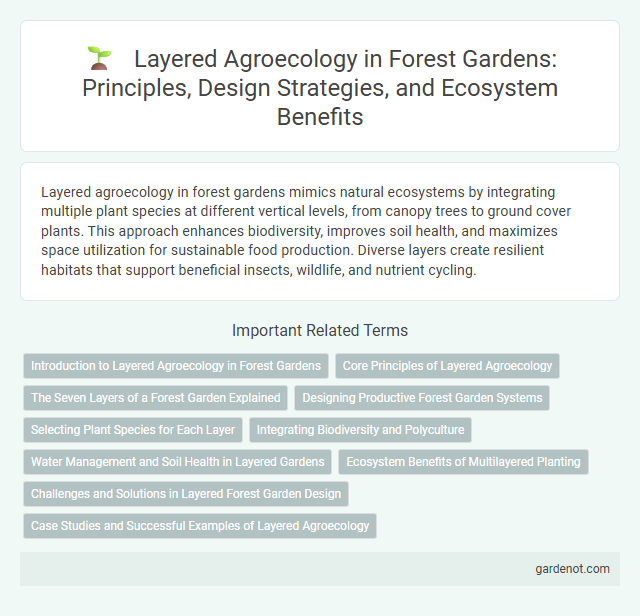Layered agroecology in forest gardens mimics natural ecosystems by integrating multiple plant species at different vertical levels, from canopy trees to ground cover plants. This approach enhances biodiversity, improves soil health, and maximizes space utilization for sustainable food production. Diverse layers create resilient habitats that support beneficial insects, wildlife, and nutrient cycling.
Introduction to Layered Agroecology in Forest Gardens
Layered agroecology in forest gardens integrates multiple vegetation strata to enhance biodiversity, soil health, and microclimates. This approach mimics natural ecosystems by combining canopy trees, understory shrubs, herbs, ground covers, and root crops, maximizing space and resource efficiency. By fostering symbiotic plant relationships, layered agroecology promotes sustainable food production and resilient agroecosystems.
Core Principles of Layered Agroecology
Layered agroecology integrates multiple vertical strata within a forest garden, optimizing biodiversity and resource use efficiency through diverse plant architectures and functional roles. Core principles include mimicking natural ecosystems, enhancing soil health with organic matter, and promoting synergistic interactions among plant species to improve resilience and productivity. This approach supports sustainable food production by balancing ecological functions and reducing dependency on external inputs.
The Seven Layers of a Forest Garden Explained
The Seven Layers of a Forest Garden encompass canopy trees, low trees, shrubs, herbaceous plants, ground cover, root crops, and vertical climbers, creating a diverse, sustainable ecosystem. Each layer serves a unique ecological function, enhancing biodiversity, nutrient cycling, and habitat complexity while maximizing space and resource use. This multilayered structure mimics natural forests, promoting resilience and productivity within agroecological systems.
Designing Productive Forest Garden Systems
Layered agroecology in forest garden design maximizes productivity by integrating multiple plant strata such as canopy trees, understory shrubs, herbs, ground covers, and root crops. Each layer contributes to ecosystem services including soil fertility enhancement, pest regulation, and microclimate stabilization, promoting biodiversity and sustainable yields. Strategic spatial arrangement and species selection ensure efficient resource use and long-term resilience in forest garden systems.
Selecting Plant Species for Each Layer
Selecting plant species for each layer in a forest garden requires understanding their ecological functions and shade tolerance. Canopy trees such as oak or walnut provide nutrient cycling and sun protection, while understory shrubs like currants or blueberries thrive in partial shade. Ground covers, herbs, and root crops complete the layers by improving soil health, attracting pollinators, and maximizing vertical space for sustainable yields.
Integrating Biodiversity and Polyculture
Layered agroecology in forest gardening enhances ecosystem resilience by strategically integrating biodiversity and polyculture across vertical strata, from canopy trees to ground-cover plants. This approach promotes nutrient cycling, pest control, and soil health through diverse species interactions and complementary plant functions. Implementing multilayered polycultures maximizes land use efficiency while fostering habitat for wildlife and improving overall system productivity.
Water Management and Soil Health in Layered Gardens
Layered agroecology in forest gardens enhances water management through the strategic arrangement of plant species with varying root depths, promoting efficient water infiltration and retention. Diverse vegetation layers, including canopy trees, shrubs, and ground covers, reduce soil erosion and improve organic matter accumulation, driving soil health. This integrated approach supports a resilient ecosystem by fostering nutrient cycling and maintaining soil moisture balance.
Ecosystem Benefits of Multilayered Planting
Multilayered planting in forest gardens enhances biodiversity by mimicking natural forest structures, creating diverse habitats that support pollinators and beneficial insects. This layered agroecology improves soil health through varied root depths, facilitating nutrient cycling and moisture retention, which reduces erosion and increases carbon sequestration. The integration of canopy, understory, shrub, and ground layers optimizes sunlight capture and microclimate regulation, boosting overall ecosystem resilience and productivity.
Challenges and Solutions in Layered Forest Garden Design
Layered agroecology in forest garden design faces challenges such as species competition for light, nutrients, and water, which can reduce overall productivity. Solutions include careful selection of complementary plant species with different growth habits and root depths, as well as strategic spatial arrangement to optimize resource use and minimize shading. Implementing dynamic pruning and soil management techniques enhances biodiversity and maintains ecosystem resilience within the layered structure.
Case Studies and Successful Examples of Layered Agroecology
Layered agroecology in forest gardens integrates multiple vegetation strata, enhancing biodiversity and productivity through synergistic plant interactions. Case studies from regions like Southeast Asia and West Africa demonstrate how layered planting schemes increase yield resilience, improve soil health, and support local livelihoods. Successful examples include the use of nitrogen-fixing trees, understory crops, and fruit-bearing species combined with perennial plants, creating sustainable and self-sufficient agroecosystems.
Layered agroecology Infographic

 gardenot.com
gardenot.com